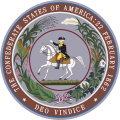| General in Chief of the Armies of the Confederate States | |
|---|---|
 | |
 | |
| The War Department | |
| Style | General |
| Type | Chief of Staff |
| Status | Military Chief |
| Reports to | The president The secretary of war |
| Appointer | The president with Senate advice and consent |
| Term length | No fixed term |
| Formation | January 31, 1865 |
| Abolished | April 9, 1865 ( de facto ) |
The general in chief of the Armies of the Confederate States, or simply general in chief, was the military commander of the Confederate States Army (CSA) from January until April 1865. The office was effectively abolished on April 9, 1865, when General Robert E. Lee surrendered to federal forces at Appomattox, Virginia. Despite being General in Chief; the title defined a role rather than making Lee something that could be called the highest ranking Confederate general officer as the seven full generals of the Confederate States were delineated solely by seniority, topped by General Samuel Cooper.

